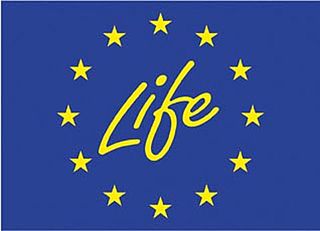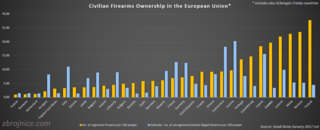Natura 2000 is a network of nature protection areas in the territory of the European Union. It is made up of Special Areas of Conservation and Special Protection Areas designated respectively under the Habitats Directive and Birds Directive, respectively. The network includes both terrestrial and Marine Protected Areas.

A directive is a legal act of the European Union which requires member states to achieve a particular result without dictating the means of achieving that result. It can be distinguished from regulations, which are self-executing and do not require any implementing measures. Directives normally leave member states with a certain amount of leeway as to the exact rules to be adopted. Directives can be adopted by means of a variety of legislative procedures depending on their subject matter.

CE marking is a certification mark that indicates conformity with health, safety, and environmental protection standards for products sold within the European Economic Area (EEA). The CE marking is also found on products sold outside the EEA that have been manufactured to EEA standards. This makes the CE marking recognizable worldwide even to people who are not familiar with the European Economic Area. It is in that sense like the FCC Declaration of Conformity used for selling certain electronic devices in the United States.

Waste hierarchy is a tool used in the evaluation of processes that protect the environment alongside resource and energy consumption from most favourable to least favourable actions. The hierarchy establishes preferred program priorities based on sustainability. To be sustainable, waste management cannot be solved only with technical end-of-pipe solutions and an integrated approach is necessary.
The best available technology or best available techniques (BAT) is the technology approved by legislators or regulators for meeting output standards for a particular process, such as pollution abatement or pasteurization. Similar terms are best practicable means or best practicable environmental option. BAT is a moving target on practices, since developing societal values and advancing techniques may change what is currently regarded as "reasonably achievable", "best practicable" and "best available".

Environmental assessment (EA) is the assessment of the environmental consequences of a plan, policy, program, or actual projects prior to the decision to move forward with the proposed action. In this context, the term "environmental impact assessment" (EIA) is usually used when applied to actual projects by individuals or companies and the term "strategic environmental assessment" (SEA) applies to policies, plans and programmes most often proposed by organs of state. It is a tool of environmental management forming a part of project approval and decision-making. Environmental assessments may be governed by rules of administrative procedure regarding public participation and documentation of decision making, and may be subject to judicial review.
In the experimental (non-clinical) research arena, good laboratory practice or GLP is a quality system of management controls for research laboratories and organizations to ensure the uniformity, consistency, reliability, reproducibility, quality, and integrity of products in development for human or animal health through non-clinical safety tests; from physio-chemical properties through acute to chronic toxicity tests.

The Landfill Directive, more formally Council Directive 1999/31/EC of 26 April 1999 is a European Union directive that regulates waste management of landfills in the European Union. It was implemented by its Member States by 16 July 2001.

The Control of Substances Hazardous to Health Regulations 2002, as amended, is a United Kingdom Statutory Instrument which states general requirements imposed on employers to protect employees and other persons from the hazards of substances used at work by risk assessment, control of exposure, health surveillance and incident planning. There are also duties on employees to take care of their own exposure to hazardous substances and prohibitions on the import of certain substances into the European Economic Area. The regulations reenacted with amendments the Control of Substances Hazardous to Work Regulations 1999 and implement several European Union directives.
The Energy Performance of Buildings Directive (EPBD) is the European Union's’s main legislative instrument aiming to promote the improvement of the energy performance of buildings within the Community. It was inspired by the Kyoto Protocol which commits the EU and all its parties by setting binding emission reduction targets.
The Strategic Environmental Assessment (SEA), is a process in Denmark for assessing the environmental effects of proposed government projects and programmes. Established in 1993 by an administrative order of Denmark's Prime Minister’s Office, this requirement was not initially enshrined in law, but was supported by a government circular which required an SEA to be carried out on “government proposals with major environmental effects”. The SEA process was limited only to government proposals and did not extend to plans and programmes. SEAs were required to focus on the impacts proposals would have on physical, ecological, cultural, health and risk factors. In 1995, the SEA requirement was extended to new parliamentary acts in addition to government proposals at the national level.

The Urban Waste Water Treatment Directive is a 1991 European Union directive concerning urban waste water "collection, treatment and discharge of urban waste water and the treatment and discharge of waste water from certain industrial sectors". It aims "to protect the environment from adverse effects of waste water discharges from cities and "certain industrial sectors".

The LIFE Programme is the European Union’s funding instrument for the environment and climate action. The general objective of LIFE is to contribute to the implementation, updating and development of EU environmental and climate policy and legislation by co-financing projects with European added value.
The Floods Directive is legislation in the European Parliament on the assessment and management of flood risks. The floods directive basically prescribes a three-step procedure:

The term Environmental persistent pharmaceutical pollutants (EPPP) was first suggested in the nomination in 2010 of pharmaceuticals and environment as an emerging issue in a Strategic Approach to International Chemicals Management (SAICM) by the International Society of Doctors for the Environment (ISDE). The occurring problems from EPPPs are in parallel explained under environmental impact of pharmaceuticals and personal care products (PPCP). The European Union summarizes pharmaceutical residues with the potential of contamination of water and soil together with other micropollutants under “priority substances”.
The European Union (EU) is considered by some to have the most extensive environmental laws of any international organisation. Its environmental policy is significantly intertwined with other international and national environmental policies. The environmental legislation of the European Union also has significant effects on those of its member states. The European Union's environmental legislation addresses issues such as acid rain, the thinning of the ozone layer, air quality, noise pollution, waste, water pollution and sustainable energy. The Institute for European Environmental Policy estimates the body of EU environmental law amounts to well over 500 Directives, Regulations and Decisions.
Strategic environmental assessment (SEA) is a systematic decision support process, aiming to ensure that environmental and possibly other sustainability aspects are considered effectively in policy, plan and program making. In this context, following Fischer (2007) SEA may be seen as:

The European Firearms Directive is a law of the European Union which sets minimum standards regarding civilian firearms acquisition and possession that EU member states must implement into their national legal systems.

A pesticide, also called Plant Protection Product (PPP), which is a term used in regulatory documents, consists of several different components. The active ingredient in a pesticide is called “active substance” and these active substances either consist of chemicals or micro-organisms. The aims of these active substances are to specifically take action against organisms that are harmful to plants. In other words, active substances are the active components against pests and plant diseases.